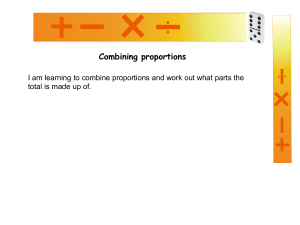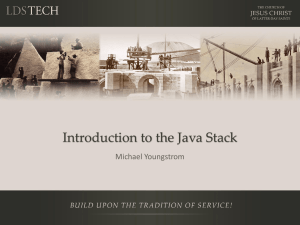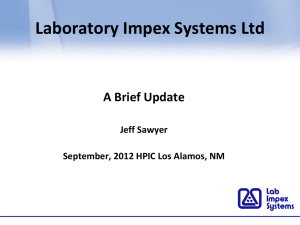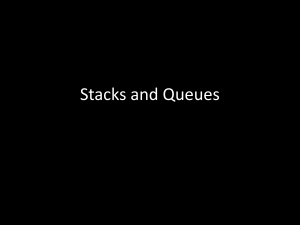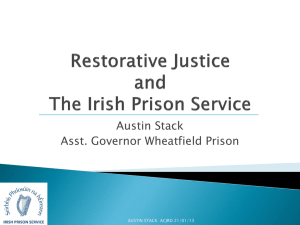KickingUpTheDust-v2 - Bill Scott`s Portfolio
advertisement
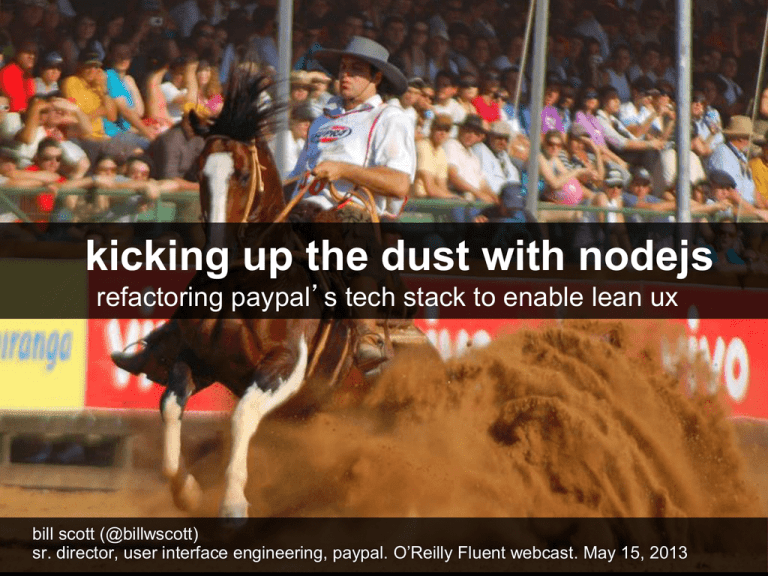
kicking up the dust with nodejs
refactoring paypal’s tech stack to enable lean ux
bill scott (@billwscott)
sr. director, user interface engineering, paypal. O’Reilly Fluent webcast. May 15, 2013
at Netflix 90% or more of
the “ui bits” were thrown
away every year.
doesn’t take too many
tests to result in lots of
throw away code.
followed buid/test/learn
the epiphany
design for volatility
paypal vs netflix
paypal circa 2011
roll your own.
disconnected delivery
experience. culture of
long shelf life. inward
focus. risk averse.
tangled up
technology
big problem. technology
and processes not geared
to build/test/learn.
new dna @paypal
jan 2012
fleshed out ui layer that could
support rapid experimentation
march 2012
david Marcus becomes
president of PayPal
april 2012
formed lean ux team to reinvent
checkout experience
in the midst of transformation
a tale of two stacks (c++ & java)
proprietary
long
ui
proprietary
ui
release
cycles
xml
jsp
two non-standard stacks
new stack tied to Java
c++
java
old
new’ish
“one word” change could
take 6 weeks to fix on
c++ stack
decision was to move to java
proprietary
ui
proprietary
ui
xml
jsp
c++
java
old
new’ish
migration was already in
place to leave the
c++/xml stack behind
some odd choices
preceded this: write
everything in java (html,
css & js!!)
but we wanted to support lean ux
enabling a living spec
whiteboard
to code
product/design
team
code to usability
user interface
engineers
engineering stack requirements
treat prototype & production the same
allow rapid sketch to code life cycle
allow quick changes during usability studies (RITE)
support being the “living spec”
usability/customers
lean ux
designing products for
build/measure/learn (lean
startup)
requires 3 rules to be followed
at all times
get to & maintain a shared
understanding
form deep collaboration
across disciplines
keep continuous customer
feedback flowing
free to iterate and drive agile
FOCUS ON LEARNING
usability
usability
usability
usability
usabili
lean ux - lean team track
agile
{
user interface engineering - agile scrum team
sprint 0
engineering - agile scrum team
release
release
release
FOCUS ON DELIVERING (& LEARNING)
release
engineering
engineering
for learning
old stack not designed for
learning
prototyping
was hard
“ui bits”
could only
live here
proprietary
ui
jsp
java
this new stack was not
conducive to prototyping
followed an “enterprise
application” model. ui gets
built into the “app”
ajax/components all done
server-side (subclass java
controller)
step 1
set the ui bits free
separate the ui bits
templates = JS
{dust}
style = CSS
(less)
code = JS
(backbone)
re-engineered the
user interface stack so
that the only artifacts
are:
images
ditched the server-side
mentality to creating UIs
no more server-side only
templates
•
•
javascript
•
css
no more server-side
components
•
images
•
•
no more server-side
managing the ui
use javascript templating
templates = JS
{dust}
code = JS
(backbone)
style = CSS
(less)
images
templates get converted
to javascript
javascript
executed
to generate ui
<p>Hello {name}</p>
compiles to...
JavaScript
we use dust.js
ui bits now just natural web artifacts
templates = JS
{dust}
code = JS
(backbone)
style = CSS
(less)
server-side language independent
server/client agnostic
CDN ready
cacheable
rapid to create
images
portable in all directions
either stack
{dust}
JS template
node.js
prototype
stack
{dust}
JS template
java
(rhinoscript)
production
stack
client OR
server
JS templating can be run
in client browser or server
on the production stack
we can drag & drop the ui
bits from prototyping stack
to the production stack
started using nodejs for proto stack
enabled rapid development (coupled with dustjs)
whiteboard
to code
product/design
team
{dust}
code to usability
usability/customers
user interface
engineers
backbone
less
images
node.js (set up as prototype stack)
free to turn sketch to code
forcing function.
brought about a close collaboration between engineering
and design
created a bridge for shared understanding
required a lot of confidence and transparency
free to test frequently with users
step 2
embrace open source
use open source religiously
work in open source model
internal github revolutionized our
internal development
rapidly replaced centralized
platform teams
innovation democratized
every developer encouraged
to experiment and generate repos
to share as well as to fork/pull request
give back to open source
we have a string of projects that will be open sourced
node bootstrap (similar to yeoman)
contributions to bootstrap (for accessibility)
and more...
step 3
release the kraken
project kraken
ready nodejs for production
enable all of standard paypal
services
but do it in a friendly npm way
monitoring, logging, security,
content, local resolution, analytics,
authentication, dust rendering,
experimentation, packaging,
application framework, deployment,
session management, service access, etc.
mvc framework/scaffolding. hello world in 1 minute.
one stack to rule them all
{dust}
JS template
node.js
prototype
&
production
stack
client
server
single stack creates
seamless movement
between lean ux and
agile
blended team
app is the ui
introducing nodejs into your org
get the camel’s nose under the tent
- start as an API proxy (shim) to really old services
- use as a rapid prototyping stack
move into the tent
- find a good proof of concept API or application to begin
to scale
- do it in parallel and test till scales
do it with talent
- ensure best developers are on the initial work to set the
standard
a few other key items
github democratizes coding & decentralizes teams
bower provides a clean way to componentize the ui
requirejs makes packaging simple and enforces modules
running internal npm service drives modularization
having a CLI for creating/extending apps is empowering
less cleans up css code
backbone provides standard client event modeling
the steps we took
set the ui free
embrace open source
release the kraken
follow me on twitter
@billwscott


